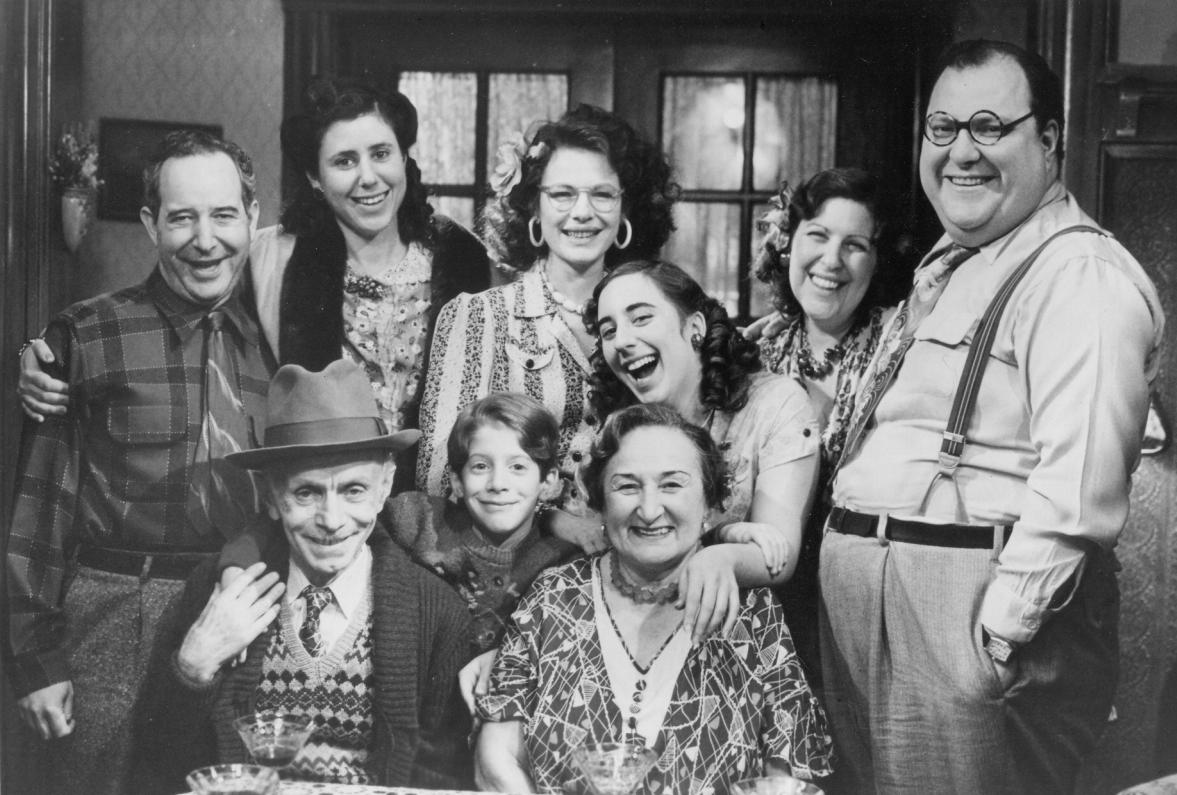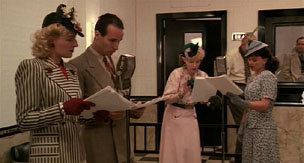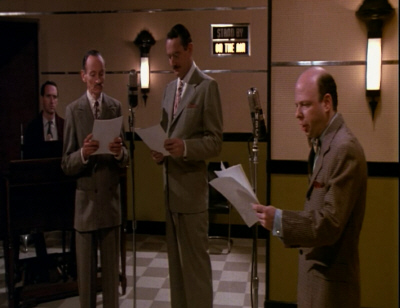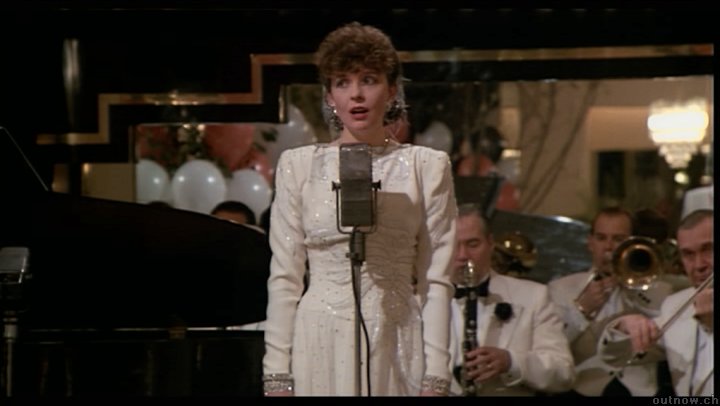This is the very first long review I ever published in the Chicago Reader. It was published in their March 13, 1987 issue, about five months before I moved to Chicago from Santa Barbara and started working as their regular film critic, and writing this piece was part of my audition for the job. (They commissioned two other pieces from me, neither of which they ran, as part of the same audition; both of these reviews — on Oliver Stone’s Platoon and on Bertrand Tavernier’s ‘Round Midnight — are now available on this site.)
This article has never previously appeared online, on the Reader’s website or anywhere else. It ran originally with the same black and white still reproduced here. Readers familiar with my essay, “Notes Toward the Devaluation of Woody Allen,” written about three years later, may notice that I borrowed a few passages in it from this review. My original title for this review, “Woody’n You,” was rejected by the Reader editors, who didn’t catch or dig the jazz reference. — J.R.
*RADIO DAYS
Directed and written by Woody Allen
With Seth Green, Julie Kavner, Michael Tucker, Mia Farrow, Dianne Wiest, and Diane Keaton.
It’s hard to think of a contemporary American filmmaker who is more universally admired than Woody Allen –- a fact that may say more about us than it says about Woody. For the curious thing about this poet laureate of our collective uncertainties, this ultimate auteur and film artist –- even if we acknowledge all of his very real talents and claims on us -– is that he may not be an auteur or a film artist at all.
As a comic writer, Allen is easily the equal of Benchley and Perelman, and conceivably within hailing distance of Thurber. As a performer, it is largely his lack of actorly presence -– his badge of authenticity -– that endears him to us; nothing is more reassuring about his persona than the acute sense of failure that he brings to every activity, making every small victory, every flicker of warmth or hope into an inspirational triumph. As a writer-performer-persona, he is probably as personal as it is possible for someone in his position to be. But as a director and filmmaker, even after 16 features, he remains strangely unformed and unrealized -– not a creator of forms or even a distinctive stylist who can exist independently of his models.
At one time or another, Allen has been compared by respectable critics to Antonioni, Bergman, Chaplin, Fellini, Keaton, Renoir, and Welles. But the most obvious difference between him and his masters is his inability to operate as if these other filmmakers never existed. Director-critics like Godard, Rivette, Truffaut, and Chabrol usually teach us something about their artistic models, but Allen can only hide behind his own, whether these be filmic or literary. (Whether he deserves comparison to Bellow, Doctorow, Chekhov, or Tennessee Williams seems equally questionable, for equivalent reasons.)
The interesting thing about Radio Days, not one of his sturdier efforts, isn’t what it cribs from other sources –- Fellini’s Amarcord for structure, early Truffaut for prepubescent voyeurism and horniess, Monty Python for a Grand Guignol baseball anecdote, Doctorow for ambience, Allen’s own The Purple Rose of Cairo for its condescending Little People theme. Much more important is what it tries for and flubs in its own right. Following the radio culture of a working-class Jewish family in Rockaway Point from around 1938 through New Year’s Eve 1943, without much sense of time passing or of characters changing, the film aims for a nostalgic recreation of what radio meant in that period, but lacks a secure vantage point or conceptual base for conveying this with any depth. Apart from offering a few familiar period touchstones and a characteristically adept choice of pop tunes, it can only come up with vaudeville routines and another version of Woody himself (as offscreen narrator to his preteen look-alike, Little Joe, played by Seth Green) to paper over the cracks in what it can only pretend to convey.
Having grown up in the immediate aftermath of the period covered, I remember something of what radio meant, which had a lot to do with the imaginary movies one constructed to go along with the voices, music, and sound effects. It is possible, if difficult, to show us realistic glimpses of shows being broadcast from studios while still allowing us to construct our own imaginary visual accompaniments to the sounds. Joseph Sargent’s The Night That Panicked America, which focused on the celebrated 1938 War of the Worlds broadcast — an event cursorily touched on in Radio Days — pulled off this delicate feat with some aplomb. Allen provides us with countless images of radio listeners and radio performers, but whether the latter images are his own fantasy constructions or the listeners’ is not always clear. Either way, the absence of a clear distinction between the real and the imaginary effectively blocks us from constructing our own versions, thereby depriving us of precisely the experience that the movie asks us to share. When, late in the film, Joe gets taken by his Aunt Bea (Dianne Wiest) and her date Sy (Richard Portnow) to a live radio show for the first time in his life, the effect is clearly meant to be mythical and magical, like Joe’s visit with Bea and another date to Radio City Music Hall. But by this time, we have already been shunted through so many similar radio shows in person that the setting seems as familiar and mundane as the family household, and Woody’s enthusiastic recollection of the event on the sound track essentially falls on deaf ears.
The irony of all this is that Radio Days is principally conceived in terms of narration, dialogue, and music, and might have found its ideal form as a radio play. The secondhand quality of the images suggests that they’re merely illustrations of ideas and situations that were already born full-grown on the page, so that they often register like afterthoughts rather than realizations or improvisations. This is inadvertently demonstrated by Thierry de Navacelle’s recent Woody Allen on Location (William Morrow), a diary of the shooting of Radio Days that also conveniently includes in parallel columns the original script and the first cutting continuity that followed the shooting, allowing one to trace the project’s confusions from first stage to last. Despite over 400 pages of hagiography about Allen’s “genius” and “perfectionism” on a set (as well as his daily moods, wardrobe, and breakfast preferences), Navacelle still confirms with this gathered evidence that the most creative stages on any Allen project are the writing and the editing.
Several years ago, Ralph Rosenblum a book of his own described in detail how he substantially reworked Allen’s unformed and scattershot rough cuts on half a dozen early features — even successfully demanding that Allen shoot new endings to Take the Money and Run, Bananas, Sleeper, and Love and Death, and transforming a self-centered smorgasbord called Anhedonia (“the inability to experience pleasure”) into a graceful romantic comedy called Annie Hall. And while Rosenblum no longer edits Allen’s pictures (a job presently performed by Susan E. Morse), de Navacelle’s book amply shows that there is still a yawning abyss between Allen’s original conceptions and what eventually winds up on the screen. Part of this appears to be a judicious pruning of his compulsive morbidity: Take the Money and Run originally ended with the bloody annihilation of its hapless hero, while Radio Days originally began with the drowning of a Houdini type performing an underwater stunt in the 20s and its awkward radio coverage. But an equally important part of the problem seems to be that Allen usually starts with a literary conception rather than a filmic one. As he pointed out to Godard in a videotaped interview last year, he regards the intertitles or chapter headings in Hannah and Her Sisters as a literary device (i.e. as words), while Godard uses them in his own films as a cinematic device (i.e. as shots).
Allen is far from being the only comic director who thinks verbally more than visually; the same is true of Mel Brooks, and it may have something to do with the nature of Judaism as an oral culture. This tendency is tied, in any case, to the increasing formal problem in Allen’s work of integrating his comic, actorly persona with his more serious aspirations as a filmmaker. Each of his last films has proposed a radically different solution for injecting Woody into a plot: incorporating him into mock newsreels in Zelig, bringing him back as a sympathetic romantic hero in Broadway Danny Rose, using Mia Farrow as a Woody substitute in The Purple Rose of Cairo, and isolating him like a bacteria in a parallel plot throughout most of Hannah and Her Sisters. In effect, Radio Days gives us four separate Woodys: narrator, Little Joe, and, more intermittently, Mia Farrow and Dianne Wiest, the latter already suggested as a female Woody in Hannah.
A better sense of how Allen handles these problems of language and persona can be deduced by comparing his strategies with those of Chaplin, Tati, and Jerry Lewis. For Chaplin, speech brings about a transformation of the Tramp at the end of The Great Dictator, and then his elimination from all the subsequent films. Tati’s Monsieur Hulot, initially designed to appear only in Mr. Hulot’s Holiday, is furnished with a wealthy sister and nephew in Mon Oncle, multiplied and universalized by various look-alikes (to prove that we are all potential Hulots) in Playtime, brought back in desperation as the central hero of Trafic after the commercial disaster of the former film, and finally abandoned with relief in Parade; in all these films, speech is overheard more than heard, and sound in general is used to complement and punctuate (rather than illustrate) the image. Lewis, in his own films, while not doing much to alter his character (apart from adjusting to the effects of aging), accompanies his bodily deformations with deformations of language, creating a kind of spastic Jabberwocky at moments of hysteria to reflect his gangling physical instability.
Like Allen, these actors/writers/directors can be regarded as autobiographical artists in the deepest sense, their gags springing directly from their lives and experiences. (While this might seem less obvious with Lewis, it is worth noting that his last feature, Cracking Up, has slapstick sequences alluding to both his open-heart surgery and his near-suicide.) All three can also be said to be animated by a conflict between self-love and self-hatred in relation to their comic personae; but where they differ crucially from Allen is in the degree to which they express this conflict dialectically. Rather than work both sides of the street, as Allen does, they usually maintain enough distance from their own characters to allow audiences to have a critical perspective on them. Allen, by contrast, is too close to Woody to allow us this detachment; his task, on the contrary, is to seduce us into sharing his character’s confusions and ambivalences without being able to sort them out. (After all, Woody can’t sort them out, so why should we?) And rather than propose an artistic solution to a personal conflict as Chaplin, Tati, or Lewis do, he offers a kind of aesthetic smokescreen designed to keep us from realizing that the conflict isn’t being squarely faced.
A major distinction here is social context. Chaplin and Tati offer characters whose main problem is coping with the world; Lewis and Allen’s characters, on the other hand, are concerned with both coping and scoring, and the importance of scoring –- greater in Allen’s case than in Lewis’s, and central to the story of Mia Farrow’s Sally White in Radio Days — implies a different relationship to the society in question. Chaplin and Tati are profound social critics because their characters’ difficulties in coping with society lead to a consideration of society’s difficulties in coping with them. Lewis carries over some of this process, but Allen virtually abandons it. Apart from loving self-deprecations, and the daring jibes against his audience in Stardust Memories, his social critiques seldom get beyond the range of one-liners, while the obsession with success and scoring usually implies that it is the oddball individual and not the society that needs to make adjustments. This meshes perfectly with Allen’s desire to play Insider and Outsider at the same time, a double agent without allegiance to either side who makes us feel better about the complacent vanity of our own political impotence.
This might seem unduly harsh for an innocuous little comedy like Radio Days, which spins out affectionate, recollected anecdotes about losers in the manner of quaint Hasidic tales — a project also followed in the more likable Broadway Danny Rose. But the corrupt winners, the radio stars — including Sally White, the loser who eventually becomes one — are as important to the film as the losers, and the cold-hearted misanthropy, provincialism, and middle-class snobbery that are celebrated in the winners redound on the losers as well. The warm superiority assumed by the narrator toward his family and former neighborhood and the abject inferiority that Sally initially feels toward her show-biz idols are cut from the same cloth; suffusing both realms with nostalgia while taking potshots at each side from the other, Allen refuses to commit himself wholly to either group or even to own up to that refusal — a decision that would shape and delimit the scope of his gags and allow them to work together.
In all fairness to Radio Days, there is one extended, climactic sequence near the end that is uncharacteristically complex and moving, in conception as well as direction –– even if Allen’s failure to do it total justice is sadly symptomatic. While Aunt Bea and cousin Ruthie are dancing the conga to radio music in the dining room, other running gags are brought into the picture: Uncle Abe appears with eels, the grandparents are looking for a lost set of false teeth, and Mom and Pop are chasing after Joe for destroying Mom’s coat with his new chemistry set. Eventually Pop catches Joe and starts to beat him — an action that seems unusually prolonged and uncomfortable in a film that depends chiefly on blackout gags. Then everyone stops what they’re doing to listen to a special radio bulletin about Polly Phelps, an eight-year-old trapped in a well for seven hours. We cut away several times to the site of the accident itself, and to other families, couples, and groups solemnly listening to the same ongoing reports of the attempts to retrieve the little girl. By the time Polly Phelps is found dead, Pop is tenderly caressing Joe, and one feels both the family and the larger community of listeners drawing together for mutual solace over this impersonal tragedy, which immediately supplants all of their own problems.
Clearly Allen is getting at something about the national experience of radio here, and expressing a keen sense of loss that this kind of experience is no longer available to us. But even this sequence is less than it could have been because of the gratuitous and distracting cutaways to the scene of the accident — offering an experience that has nothing to do with radio, but a great deal to do with a film audience trained on television (and trained by television to believe that seeing something is somehow equivalent to knowing it). The whole meaning of the sequence is tied to the shared experience of listening, but Allen can’t resist diluting and confusing it with something that none of the listeners share, the physical fact of the accident itself -– thereby placing us in a falsely superior position to all of the characters at the same time that he draws them all together. But offering us too many vantage points, he finally risks leaving us with none at all.




